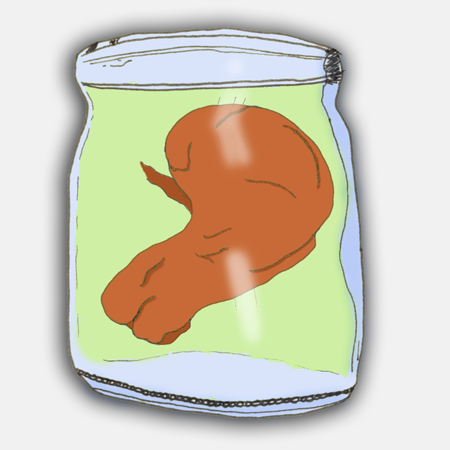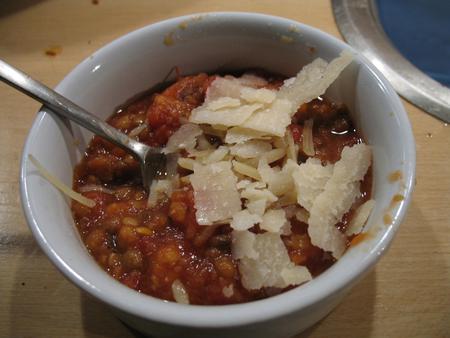TannieSpace
geekery, drawing and then some
Invisible Shield
Because the scratch-resistent part of my iPhone scratched I decided to get some protection, may or may not work, but I figured it wouldn't hurt.
I ordered a shield for the front over at Zagg and thanks to a bit of looking around I got a nice discount (and they now offer a 30% discount till 2008-12-31) and free shipping. For more discount codes check out Chris Pirillo's site. I also have two codes for a 20% discount valid until 2009-01-25, so if you want one drop me a note.
I have not yet tried these shields, but I hear they work really well. They sell them for all kinds of phones and cameras and laptops.
Optimised for phone browsers
[gallery link="file"]In an attempt to make my site more iPhone-friendly (and other phone-browsers) I installed MobilePress. It seems to work very nicely, displaying the last five posts and offering a link at the bottom for the full version.
Images also get displayed nicely, and you can even leave comments. Comments don't display automatically, you'll have to tap the link.
Knit knit away!
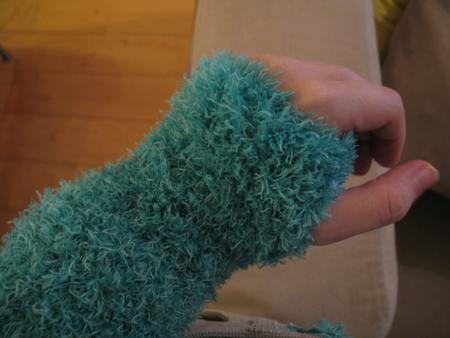 I happily started some form of knitting with my addi Express circular knitting machine. Handling needles hurts my hands a lot and this little machine at least lets me do some creative stuff, knitting-wise. I made two armwarmers, in a happy turquoise colour.
I happily started some form of knitting with my addi Express circular knitting machine. Handling needles hurts my hands a lot and this little machine at least lets me do some creative stuff, knitting-wise. I made two armwarmers, in a happy turquoise colour.
Hello, armwarmer
A Christmas card for all of you
 I haven't sent out cards in years and I don't mind at all. I get a few, but less and less each year. Reciprocation plays a big role in the Christmas-card-business ;)
I haven't sent out cards in years and I don't mind at all. I get a few, but less and less each year. Reciprocation plays a big role in the Christmas-card-business ;)
However, I wanted to post a digital one, one I made years and years ago (actually had them printed too, last time I sent out real cards). So there you go. My Christmas-card to the world, very personal ;)
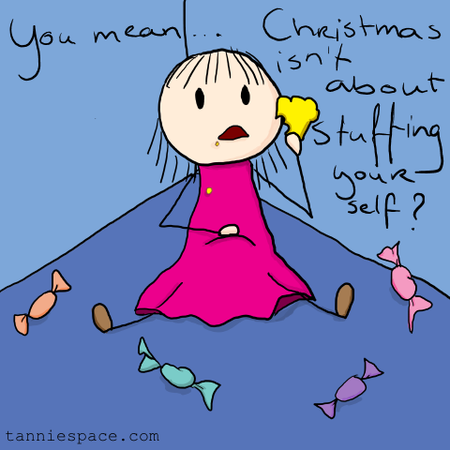 In my search for it I found another image I had forgotten all about, but did not want to leave out.
In my search for it I found another image I had forgotten all about, but did not want to leave out.
Happy stuffing! :)
Christmas - back in the day.
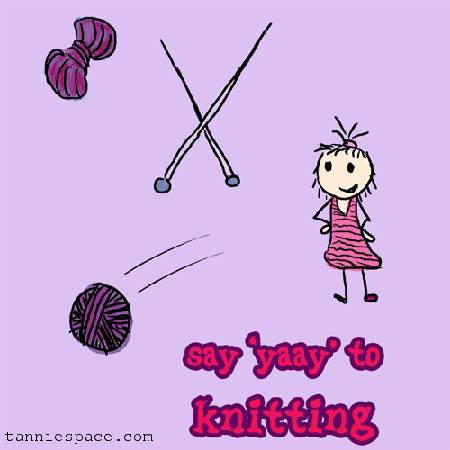 From my earliest Christmases I don't remember much. I know we had a tree, I know this one time my sister and I both got the same doll. She got the yellow one, I got the pink one. I still have it, in a box though.
In the years that followed we always had some sort of tree, and decorating it would result in a big mess cause we'd forget to put the lights in first, or they wouldn't work and we forgot to check. We'd also have hot chocolate with it.
As a tradition, we (the kids) got a plate full of candy and snacks, a German tradition I think. We'd exchange the candy we didn't like and it had to last the entire Christmas-break. We could eat it all in one day, but that would mean no candy for the rest of the time. Excellent tradition! :-)
From my earliest Christmases I don't remember much. I know we had a tree, I know this one time my sister and I both got the same doll. She got the yellow one, I got the pink one. I still have it, in a box though.
In the years that followed we always had some sort of tree, and decorating it would result in a big mess cause we'd forget to put the lights in first, or they wouldn't work and we forgot to check. We'd also have hot chocolate with it.
As a tradition, we (the kids) got a plate full of candy and snacks, a German tradition I think. We'd exchange the candy we didn't like and it had to last the entire Christmas-break. We could eat it all in one day, but that would mean no candy for the rest of the time. Excellent tradition! :-)
One thing I also remember fondly: getting knitted jumpers my mom made in the weeks before. She'd sometimes let us pick the colour, but no more than that. This month I've thought a lot about starting to knit (usually I crochet). Digging through my harddrive I found this little drawing I made years ago, about knitting. I stil like it. :-) Considering patching it up a bit though.
Midnight snack
Sleepy dog
Posting from phone
Financial programs for the mac.
Many people have written about this before, and many more will follow. What can I say, I couldn't help myself.
I like staying on top of my finances, it reduces stress and makes life in general a lot easier. I won't go into the psychological reasons why people get into debt and how to use psychology or blackmail to get yourself out. I merely want to give my thoughts on some of the software for macs out there.
I always look for the best software to fit my needs. I like computers and I feel they should make my life easier. Software can actually do that (and also make us hate it so much we want to drag it outside and beat it to a pulp).
I've tried several financial programs for my personal finance:
- iBank (OS X, Full version $59.99)
- Moneydance (OS X, Windows, Linux, $39.99)
- GnuCash (OS X, Linux, open source, free)
- MoneyWell (OS X, $49.99 / currently $39.99)
First a list of what I want in personal finance software:
- Easy to use
- Easy to set up
- Easy to maintain
- Easy to see at a glance how I did in a certain month
- Budgetting
The software should also not crash and lot eat up my data. Saving my data in some type of file that I can access outside the program scores a lot of extra points. Exporting to .qif or a similar common format sounds good to me as well.
More points get acquired if the program works well on a smaller screen and older mac. I have a iBook G4, a bit of an oldie now, which still works pretty well, but I don't need some fancy new software that only runs on an Intel with 3gb of ram. Personal finance software should not push my mac to its limits.
Behind the cut I will describe my experiences with these four programs and wrap it up with a winner.
I will do the following actions to judge the program:
- Installation.
- Open the program (startup-time)
- Import previous data (a sample .qif file)
- Create a few transactions
- Schedule some bills
- Set up a budget
- Set up a payment plan for my creditcard / loan.
The sample file has data on a savings account, a credit card and a joint checking account.
Comparison of the programs:
Installation.
All except GnuCash install easily, GnuCash takes a day or say, not very convenient. It has plenty of dependencies.
Startup.
Both MoneyDance and MoneyWell start up fast, iBank takes longer and GnuCash takes longest, due to having start up X11 first.
Creating new document.
When you create a new document iBank will create categories without asking. MoneyDance lets you choose between a standard account set and a minimal account set. MoneyWell will ask you to create buckets (categories), which you can deselect if you want. GnuCash lets you choose between a lot of sets of accounts, from basic to extended.
Importing.
Importing didn't go very well for iBank, which created multiple accounts for the same accounts. Also, the other programs had some problems with transfers. MoneyWell takes considerably longer to import. MoneyWell, MoneyDance and GnuCash let you easily enter the date format, iBank had more issues with it. IBank also required a separate file for each account to import properly. Using one file caused iBank to create ten accounts for the same account, what a mess!
New transactions.
IBank, MoneyDance and MoneyWell let you create a new transaction by pressing :cmd:-N, GnuCash lets you press enter once you set this up in preferences (Register Defaults). Entering doesn't look complicated, the fields have clear names. GnuCash works according to the double-entry bookkeeping, which sounds really complicated but with the default settings the columns will simply say 'Deposit' and 'Withdrawl', which should make it easy enough. The others let you do it in a common people way, nothing wrong with that.
Deleting transactions.
MoneyDance and MoneyWell let you select multiple transactions and delete them easily. MoneyWell has an excellent 'undo' to reverse the deletions. GnuCash makes you delete the transactions one by one. When I tried to delete 20 and then 10 transactions in iBank it started to beachball and crashed on me several times. So this may or may not work.
(note)Due to iBank slowing down my system and crashing / beach-balling a lot up to this point, I had to ditch it. I couldn't handle it anymore after the above tests.
Scheduling.
All of the three remaining programs let you schedule bills / payments very easily. You can either enter them by hand or right-click an existing payment and use that, which helps a lot if you have imported previous data. They all have several useful frequency options.
GnuCash will add the transaction into the register based on your preference, say 7 days ahead. Once added you can change it in the register, but changing the scheduled payment will not change the one in the register. GnuCash has no way of 'looking ahead' based on scheduled payments.
Moneydance will put reminders on your 'homepage' or auto-commit them, which will make them show up in your register where you can edit them, and like with GnuCash, it becomes a stand alone payment.
MoneyWell lets you schedule payments and have them show up at the bottom of your register. Changes you make here (apart from date) will trigger a pop-up asking you if you want to change it just for this one or for all future ones as well. By showing future transactions you can also scroll through the graph at the bottom to see your future income and planned spending.
Budgetting.
Setting up a budget can help you prevent spending more than your income. MoneyDance lets you set up several budgets and track them in the top bar. It can calculate averages based on previous spending, and has plenty of frequency options (monthly, bi-monthly, weekly etc). You have a live graph at the top that shows how close you are to filling up your budget, but doesn't give you detailed information per budget. You can however create a memorized report to see how you do. It'll update with every transaction, so if you don't mind looking at the numbers, you can track your budget using the report.
GnuCash's budget options work similar to MoneyDance, you can set one up based on your average spending in the previous months. To track it you will have to create a report which does not automatically update, and which can take more than ten seconds to generate. I have not found a way to adjust the column-width, which makes it harder to read. It also does not have any real frequency options. You'll have to enter an annual payment once, in the month you need to pay it, or you have to divide it by twelve and fill it in for each month.
MoneyWell has an extensive budgeting options, its basis for existence. It lets you create a spending plan easily (with the help of your average spending over the past 12 months, or last year's spending) and keep track of your spending as you spend. It updates with every transaction you enter, so you can literally see your money blowing away. Always a nice sight ;). The graph at the bottom serves as a visual reminder for your buckets, which helps you keep yourself on track.
Setting up a payment plan.
MoneyDance allows you to set up a payment plan through an extension called 'Pay Off!' which helps you create a plan for your payments, but does not actually enter the payments into your register. You still have to do this manually, but the plugin does show (with a nice graph) how long it will take and how your debt decreases over time. You can easily create scheduled payments based on this information.
Pizza muffins ftw!
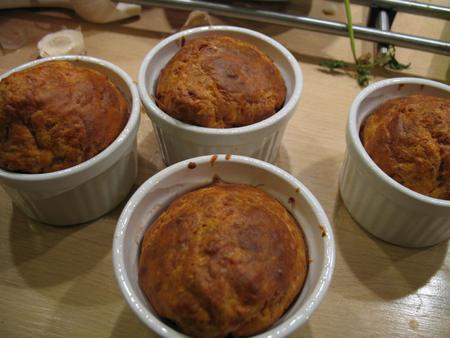 On the lookout for tasty easy snacks to make my life without a stomach a breeze, I happily stumbled over Kay's foodblog. This Dutch Girl Cooking has plenty of tasty and easy to make recipes accompanied by beautiful photography that makes my mouth water.
On the lookout for tasty easy snacks to make my life without a stomach a breeze, I happily stumbled over Kay's foodblog. This Dutch Girl Cooking has plenty of tasty and easy to make recipes accompanied by beautiful photography that makes my mouth water.
Now, my photos don't even come close to hers, but check the photo for the results of my attempt to make Pizza muffins! The recipe didn't ask for any weird stuff, I basically had everything. I did replace the pizza sauce with some home made pasta sauce which made them a bit sweeter (next time I'll use pizza sauce, I promise). I made a small batch, liked it, and then realised I had a lot of dough left. I froze it in batches, so now I only have to take one out, put it in a small ovendish and heat up that muffin. The ones on the photo turned out a bit too large for me, I adjusted the frozen batch accordingly. Also, because I don't eat ham I added an extra load of Gouda cheese :)
I don't like sweet stuff very much, and these savoury muffins just make my day.
A few TODO-list pointers.
Today I read this article over at the Neat & Simple blog about ToDo-lists. Ariane explains we're all different people and we all have different ways to have a ToDo list work for us. We also all have different reasons why some things just don't work for us. She gives some great tips to create the list that works for you and find the right tools to do it.
I wanted to add my own experiences and tricks to it so I whipped up this post.
I've recently bought myself an iPhone (you may sigh/scream if you desire). My old phone started to fail and so did my palm. Combine this with my arthritis and enter iPhone. The touchscreen helps a lot with the arthritis. I started using OmniFocus as a trusted system months for my todos before that, and happily got the iPhone app when it became available.
What to use.
Now, it doesn't really matter if you use pen and paper or a computerprogram to make your lists, you should pick whatever works for you. For me, a computerprogram works best:
- I change my mind a lot, pen and paper gets very very messy
- A computerprogram lets me hide unimportant tasks with a few clicks / shortcutkeys
- I can't write that much due to arthritis, typing goes a lot better
- I can fit more info on my screen than on a reasonable piece of pape
- I can use my phone to take notes and then sync up with my computer
If everything fails, power goes down and my phone drops dead, then yes, I'll use pen and paper. However, if that all happens at the same time I think I have bigger problems ;-)
My current setup.
So, I have a pretty simple setup:
- OmniFocus on Mac laptop
- OmniFocus on iPhone which alows me to note down tasks at any time.
How I write down tasks.
When I want to write down a task I take a few extra seconds to follow my 'pattern':
- I always start with a verb, to put me in an actionable mood. The item is something I need to do, which requires a verb, so I put it in there straight away.
- if it's a call, I use something like
call John about project xand I'll look up the number straight away and copy-paste it into the item (as a note) - if for some reason I cannot look up the number straight away, I will always make an item before the original one stating where to find the number
look up John's number in his letterUsually I know where to find it, so I'll make an extra note saying something like 'letter in archive' or 'letter on kitchen table'. I will link these items together.call Johnwill become a subtask oflook up John's number
By using a default 'template' for my actions it makes it easier for me to act on it. I know it will always say what to do (verb) with what / who (subject) about/for/because of what. If I feel like using a somewhat vague verb like 'think about' I'll take an extra minute to break it down a little into something I can actively do, and not passively. 'Thinking about' usually involves brainstorming (noting down any idea I have on the subject) and something like a pro/con list.
Beware of micro-tasking.
It takes some more time in the beginning to do this, but once you get used to it (and it fits your thinking) it'll help to clarify tasks and help you just do the task instead of having to look up that number, so you postpone it again. A successful todo-list will not make it hard on you to follow through, it will make it easy for you to do the task straight away. If you have to do things before you can actually start your task, then you should look into that, and perhaps make a task about it. Don't fall victim to micro-tasking though, you'll spend more time writing things down than actually doing it. Only you can decide where to draw the line in that. If you find you write down too little, try to do it a teensy bit more to see if you like it. And don't listen to those people who say that 'look up John's number' is a stupid task to write down, because of course you know you have to look it up. If you need to have it written down to keep going, by all means write it down. It sure saves me a lot of time and frustration and takes away the temptation of procrastination.
Adjusting.
Some time ago I had to go to the hospital.
Due to a genetic mutation I have an extremely high risk to get (and die from) a particular nasty kind of stomach-cancer. To prevent the getting and dying part, I decided to have my stomach removed (a total gastroectomy). Because this runs in the family I have seen what it can do to someone and what happens when the stomach gets removed. I've had five family-members before me, and two after me having the same procedure.
One can live without a stomach, it just takes time to adjust.
It has taken a bit more time than I expected, though, but I'll manage. Due to complications I had to stop taking my rheumatoid arthritis medication for a while, which caused it to flame up. I have started them again and now have to wait for things to calm down again, which takes a month or two.
Dealing with this consumes a lot of time (which I have plenty off) and energy (which unfortunately, I have very little off), and I try to still do fun stuff. My RA tends to flame up during winter so I suspect I have a bumpy ride ahead of me still. During this time my fridge has started to act up, something I do not want as the lack of stomach acid also means I have far less protection against evil germs in food. Luckily I saw it as an opportunity to channel my creativity into designed a new area for my fridge and pantry (with drawers, yay!).
I have found ways to boost my energy a little, so I plan to do more fun stuff (and update my poor blog a bit more cough). I'll probably post random content, of anything that keeps me busy, and drawings where possible. The RA makes drawing uncomfortable and I don't want to see drawing as something painful, I have to limit it for now.
So, who has the stomach for some horror-surgery-stories?
I just couldn't help myself!
Tomato-lentil stew
I wanted a simple stew to put in my lunchbox for a busy day tomorrow, so I basically took some stuff I had in my cupboard. It approximated this:
Ingredients:
- 1 cup water
- ½ cup lentils, red
- ½ cup lentils, brown
- 14 oz tomatoes, chopped, with herbs
- 2 tsp maggi sauce
- 1 tsp marmite
- 1 tsp pepper, grounded
- ⅓ cup parrano, grated (50 gr)
- ⅓ cup parmesan, grated (50 gr)
Directions: Cook the lentils and mix together. Simmer with tomatoes and spices for about 45 minutes. If needed drain excess liquid, and serve with grated cheese on top.
(Serves 4)
Note: I used a can of Bonduelle (brown) Lentils, dried red lentils and Heinz Tomatoes chopped, with herbs, in juice.
